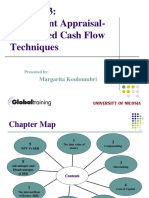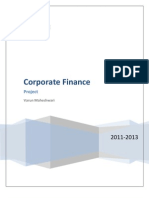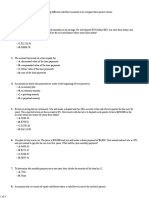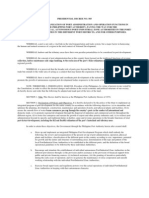0 ratings0% found this document useful (0 votes)
280 viewsFNCE Cheat Sheet Midterm 1
1) Interest rate risk increases when interest rates rise and coupon rates on existing bonds fall.
2) There are formulas for valuing annuities, perpetuities, and other cash flows under various compounding assumptions including simple, continuous, and other periodic compounding.
3) Bond valuation considers the present value of future coupon payments and face value using discount factors based on the yield to maturity. Strategies can involve combining different bonds to offset future cash flows.
Uploaded by
carmenng1990Copyright
© © All Rights Reserved
Available Formats
Download as DOCX, PDF, TXT or read online on Scribd
0 ratings0% found this document useful (0 votes)
280 viewsFNCE Cheat Sheet Midterm 1
1) Interest rate risk increases when interest rates rise and coupon rates on existing bonds fall.
2) There are formulas for valuing annuities, perpetuities, and other cash flows under various compounding assumptions including simple, continuous, and other periodic compounding.
3) Bond valuation considers the present value of future coupon payments and face value using discount factors based on the yield to maturity. Strategies can involve combining different bonds to offset future cash flows.
Uploaded by
carmenng1990Copyright
© © All Rights Reserved
Available Formats
Download as DOCX, PDF, TXT or read online on Scribd
You are on page 1/ 1
Interest rate risk= up when years up, coupon rate down
Simple annuity: PV=C((1/r)-(1/r(1+r)^t)
Continuous compounding: rannual=ln(1+rcontinuous)
Annual yield =((1+ R/# periods per year)
# of periods year
) - 1
Non-annual payment amount:(1+R)
#payments peryear
= (1+r)
Solve for R, then simple annuity using R, solve for C
Payoff remainder of loan= PV of remaining payments
Valuing Share with non-annual dividend payment: Find PV of
each payment, Po= PV(1+r)
time units remaining in year
+ PV(1+r)
time units
Discount Factor= 1/ (1+rt)
t
, use to solve for annual yield
Strategy=Buy underpriced bond Z, offset future flows with other bonds W, X and Y
Annunity PV= C((1/r)-(1/r(1+r)
t
))
Growing Annuity=C(1/(r-g) (1+g)
t
/(r-g)(1+r)
t
)
Growing annuity when r=g = (C)(T)/(1+r)
Constant Perpetuity PV = C/r
Growing Perp PV=C/(r-g)
Delayed Perp PV= C/ r(1+r)
t
Continuous annuity: 1) Solve for continuous perpetuity,
2)discount PV for # years in time frame, use annual r, 1-2=value
of continuous annuity. 1+r=e
r annual, continuous
Valuing share: 1)Stream of annual end year
payments=perpetuity. Find PV. 2)Stream of mid year payments.
PV=(PV end year)(1+rannual, # pay periods in year)
Gordon growth model: Po=Div1/(r-g) when g constant
Future value= C(1+r/#periods per
year)
#periods to maturity
FV=C(1+R)
#periods to maturity
FV=C (PV simple annuity)(discount factor)
NPV=C0 + C1/(1+r1)= C0 + Ct / (1+ rt)
t
Po/EPS1= 1/r + NPVGO/EPS1
NPV=(INVt(ROE-r))/r
G= (k)(ROE)
INV=(EPSt)(k)
DIVt=EPSt(1-k)
Divt= EPSt(1-k) g=(k)(ROE) Po=EPS1/r + NPVGO
NPVt= INVt(ROE-r) / r DIVt=EPSt - INVt
Expected Return= r = DIV1/Po + g
Annual yield=ra,1 (1+ra,1)=(1+ra,m/m)
m
= (1+R)
m
rannual rate, compunded annually=rannual rate, compound other=rnon-annual
Bond Price=C/(1+r1) + C/(1+r2)
2
+ FV/(1+r2)
2
Yield to maturity: Price=C(1/(1+r) + 1/(1+r)
2
) + FV/(1+r)
2
Yield to Maturity: Price=(Face value)(DFt) where
Price=(DFt)(Face value), DFt= 1/(1+r)
t
*Solving for r as one value, instead of using different rs*
Bond Price=(C)(DF1)+C(DF2)+FV(DF2)
Discount Factor=1/(1+rt)
t
Future rate (f): (1+r1)(1+f2,1)=(1+r3)
3
(1+fi,t)=((1+ri,t)
t+i
/ (1+rt)
t
)
1/i
*where i=# of years term lasts, t=#years in future*
Low Price to earnings ratio=valuehigh=growth
k=1-(Div1/EPS1)
EPSt= EPSt-c(1+gEPSt)
C
R= ra,m / m ra, continuous= ln (1+r)
(1+r)=(1+ra,m/m)
m
= (1+R)
m
To solve for continuous flow of C, PV=C/ra, continuous
Solve for quarterly payments for flow C, PV=Cquarter/R
Ra,continuous=ln(1+ra,1) e
r a, continuous
=(1+ra,1)
PV of stream continuously compounded for t years=
Cannual(1/ra,continuous 1/(ra,cont.)(1+r)
t
)
Effective annual rate=(1+r/m)
m
1 when r=annual %
You might also like
- 1 The Investment Industry A Top Down ViewNo ratings yet1 The Investment Industry A Top Down View21 pages
- Hand Notes On Cost of Capital and Capital Structure: Composed By: H. B. HamadNo ratings yetHand Notes On Cost of Capital and Capital Structure: Composed By: H. B. Hamad55 pages
- The Valuation and Characteristics of Bonds100% (1)The Valuation and Characteristics of Bonds56 pages
- Principles of Managerial Finance: Time Value of MoneyNo ratings yetPrinciples of Managerial Finance: Time Value of Money45 pages
- Corporate Finance: Final Exam - Spring 2003No ratings yetCorporate Finance: Final Exam - Spring 200338 pages
- Computer Oriented Statistical Methods - Lab List of ProgramsNo ratings yetComputer Oriented Statistical Methods - Lab List of Programs26 pages
- Question #1: Jordan Enterprises Raw MaterialNo ratings yetQuestion #1: Jordan Enterprises Raw Material35 pages
- Syllabus FINA 6092 - Advanced Financial ManagementNo ratings yetSyllabus FINA 6092 - Advanced Financial Management5 pages
- Cost of Capital Excel Temple-Free CH 10No ratings yetCost of Capital Excel Temple-Free CH 1010 pages
- ONAL Time Value of Money and Capital BudgetingNo ratings yetONAL Time Value of Money and Capital Budgeting51 pages
- f9 Question Bank Tuition Pack 20q Bank June 201750% (2)f9 Question Bank Tuition Pack 20q Bank June 201721 pages
- Investment Analysis and Portfolio Management: Frank K. Reilly & Keith C. Brown100% (1)Investment Analysis and Portfolio Management: Frank K. Reilly & Keith C. Brown52 pages
- Corporate Finance and Formulas and Cheat Sheet Finance 300No ratings yetCorporate Finance and Formulas and Cheat Sheet Finance 3004 pages
- Derivatives and Risk Management - Bhaskar SinhaNo ratings yetDerivatives and Risk Management - Bhaskar Sinha3 pages
- Fundamentals of Corporate Finance, 2nd Edition, Selt Test Ch06 PDFNo ratings yetFundamentals of Corporate Finance, 2nd Edition, Selt Test Ch06 PDF7 pages
- Chapter 3 (14 Ed) Analysis of Financial StatementsNo ratings yetChapter 3 (14 Ed) Analysis of Financial Statements25 pages
- Equity of Cybersecurity in the Education System: High Schools, Undergraduate, Graduate and Post-Graduate Studies.From EverandEquity of Cybersecurity in the Education System: High Schools, Undergraduate, Graduate and Post-Graduate Studies.No ratings yet
- Solutions Manual to Accompany Introduction to Quantitative Methods in Business: with Applications Using Microsoft Office ExcelFrom EverandSolutions Manual to Accompany Introduction to Quantitative Methods in Business: with Applications Using Microsoft Office ExcelNo ratings yet
- Harnessing Explosive Moves Using Gann: Jeff Greenblatt Mta Webinar MARCH 30, 2011100% (1)Harnessing Explosive Moves Using Gann: Jeff Greenblatt Mta Webinar MARCH 30, 201182 pages
- Blockchain Technology: Application in Indian Banking SectorNo ratings yetBlockchain Technology: Application in Indian Banking Sector14 pages
- Atomico - State of European Tech 2022 PreviewNo ratings yetAtomico - State of European Tech 2022 Preview117 pages
- Lloyds TSB Bank PLC: Report and Accounts 2002No ratings yetLloyds TSB Bank PLC: Report and Accounts 200243 pages
- Presidential Decree No 505 Revised by PD 857No ratings yetPresidential Decree No 505 Revised by PD 8576 pages
- Stock Cycles Forecast: First Week in August, or September?80% (5)Stock Cycles Forecast: First Week in August, or September?14 pages
- Credit Transactions Course Outline: Mr. Mark Xavier D. OyalesNo ratings yetCredit Transactions Course Outline: Mr. Mark Xavier D. Oyales3 pages
- Sample Surety Bond Form (Bankruptcy Depository Bond)100% (1)Sample Surety Bond Form (Bankruptcy Depository Bond)2 pages
- Asset Allocation and Diversification Returns: MARCH 1994No ratings yetAsset Allocation and Diversification Returns: MARCH 19947 pages
- Classification of Cost: Presented by B.Karthika I MbaNo ratings yetClassification of Cost: Presented by B.Karthika I Mba13 pages
- Educational Qualifications: Internships, Live Projects (And Startups)No ratings yetEducational Qualifications: Internships, Live Projects (And Startups)1 page
- Confirmatory Order in The Matter of Brightcom Group Ltd. Page 1 of 40No ratings yetConfirmatory Order in The Matter of Brightcom Group Ltd. Page 1 of 4040 pages

































































































